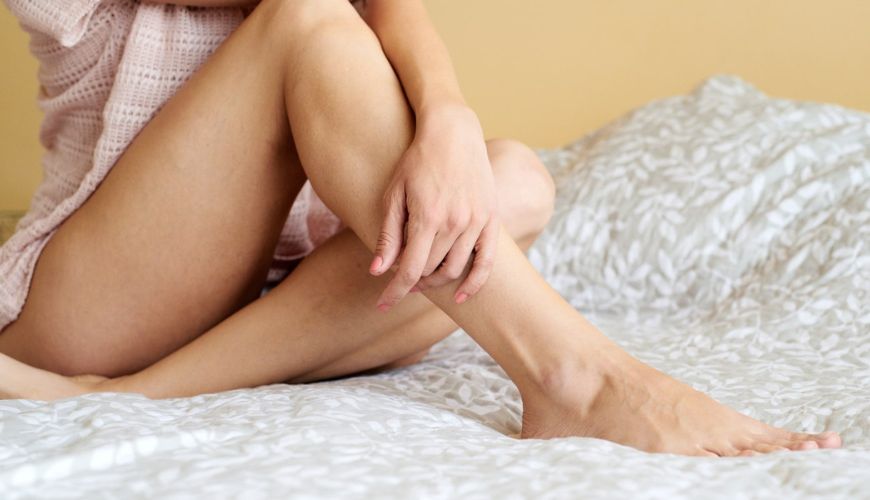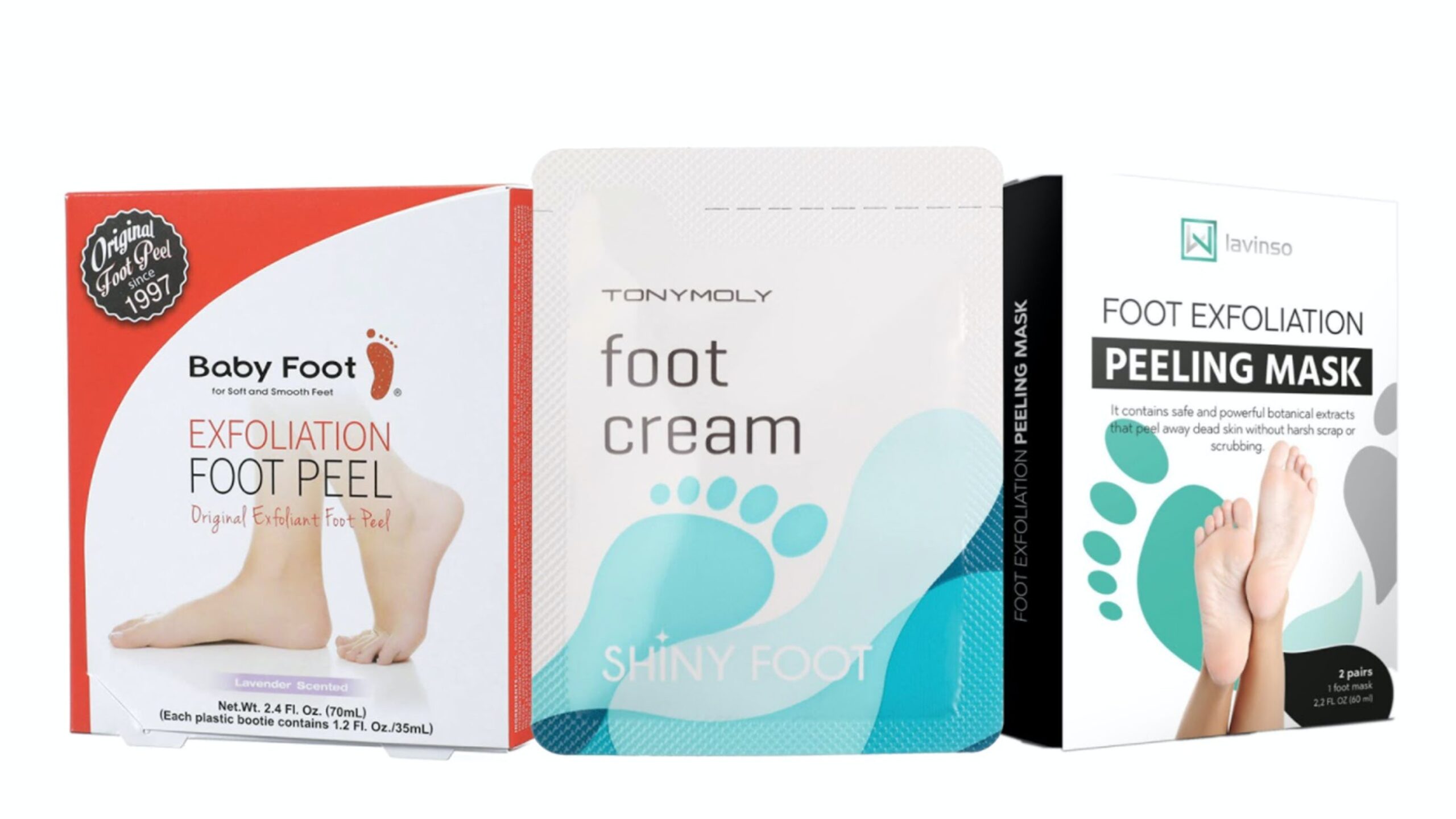Foot Peels Are The Easiest Way To Get Softer Feet At Home
[email protected] | July 31, 23

Ifeel bad for my feet. Aside from my regular visits to the nail salon, I don’t give them enough respect. I’m short, so I’ve worn uncomfortable, pinchy, high-heeled shoes for decades (and, as a result, have found the perfect foot pain-treating combo). I’ll go shoeless when I’m hanging around the house, unless I’m sporting cheap flip-flops — notoriously bad for feet! — that cause thick calluses that not even the most thorough of nail techs can slough off during a pedicure. Oh, and much to the horror of some friends, I almost never apply foot cream.
The skin on my feet is incredibly dry, rough, and hard, which is kind of embarrassing considering how much I go around preaching the value of skincare. So, finding myself with some free time, I decided to commit to the easiest, laziest way to get smoother, softer feet at home: a foot peel.
In case you’re unacquainted, foot peels are chemical peels — similar to the ones you might already be using on your face to help smooth skin and improve texture — specifically designed for feet. They’re easy and comfortable to use, and for the subsequent two weeks or so after trying one, you’ll see the dead skin shed off, leaving soft, fresh skin behind. If you’re ready to try one for the first time — or, if you’re ready to max out the results of one you already use — keep reading. I’ve tapped two doctors (a dermatologist and a podiatrist), who helped me break down the top things to know before using a foot peel.
Foot Peel Tip #1: Chemical Peels For Your Face Are Not The Same As Foot Peels.
Don’t just whip out your favorite at-home peel and start slathering or swiping it across your feet! Yes, face and foot peels both tend to be formulated with cocktails of alpha-hydroxy and beta-hydroxy acids, which eat away at dead skin to reveal the fresh new skin underneath. Famously, this can result in a little bit of flaking with at-home treatments, with more intense shedding courtesy of in-office options (thus the name, “chemical peel”).
Foot peels are so potent, however, that they result in serious sloughing, more significant than anything you might have seen even from a professional chemical peel — you’ll see legitimate sheets of dead skin coming off your heels. That’s because foot peels are designed to be much stronger than what we would put on our faces, as the tough skin of this area is actually the thickest on our body.
“The skin on the bottom of our feet is highly evolved for walking upright,” explains Heather D. Rogers, MD, founder and CEO of Doctor Rogers Restore® and co-founder of Modern Dermatology℠ in Seattle. “The skin on our feet is actually supposed to make calluses, since calluses serve as protection! They are formed in areas of constant friction to protect the skin from this wear and tear.” Interestingly enough, she notes that you actually want some calluses for a more comfortable walking experience, but when they start to look yellowish-white and cracked, they get unsightly, and it’s totally fine to remove them. That’s where a foot peel comes in.

Foot Peel Tip #2: There Are Plenty Of Options Available On The Market — Just Make Sure You Can Safely Use One.
There is no shortage of options, and for such a powerful product, they tend to be reasonably priced. BabyFoot® ($25) is an old standby of mine, and my colleague Thia enjoys TonyMoly® Shiny Foot ($14). Most recently, I tried something new, and went for LavinsoTM Foot Exfoliation Peeling Mask ($26 for two pairs).
Before investing in one of these treatments, make sure you’re an ideal candidate. “Anyone with poor circulation, chronic swelling of their lower extremities, diabetes, or a compromised immune system should be cautious about doing foot peels,” notes Dr. Rogers. These conditions could make it hard to tell if you’ve had an adverse reaction to the peel. If you’re unsure if you fall into any of these categories (or even just have sensitive skin!), the best course of action is always to ask your doctor if it’s a good idea before trying something new.
I’d used foot peels before with no issue, so I forged ahead — but it had been years since I used one, which — if my tough, cracked calluses were any indication — was far too long to wait. “I suggest doing foot peels once every change of season,” suggests Hillary Brenner, MD, a podiatrist in New York City. “If you have really dry skin, you can do it two to three times within a course of six months.”
Foot Peel Tip #3: Prime Your Feet For The Best Possible Results.
Foot peels are pretty user-friendly treatments. Typically, they consist of plastic booties lined with an acid-based gel. You simply slip on the booties and wear them for an hour, allowing the gel to penetrate the dead skin, and then remove them and rinse your feet. Usually, I don’t prepare at all for my foot peel — that is, no more than deciding what TV show to stream as I wait for the treatment to do its magic — and my feet still slough spectacularly.
However, to yield really dramatic results, there are a few steps you can take before sliding into your plastic booties. Dr. Rogers recommends showering or bathing right before your peel, so your skin is still moist. “That will allow the peel to penetrate more quickly into the dead skin,” she explains. Dr. Brenner takes it one step further, with the suggestion of soaking your feet in Epsom salts two days prior to using the peel. Like showering beforehand, this will help loosen the dead layers from the rest of your skin, promoting better penetration of the exfoliating ingredients. “After [a peel], I suggest applying a moisturizing cream twice a day and wearing socks,” adds Dr. Brenner. “The more moisture, the better the peel.”
Foot Peel Tip #4: Don’t Peel Off The Dead Skin Yourself.
Everyone who’s done a foot peel knows the grimy satisfaction of sloooooowly tugging on a tiny flap of skin to end up removing a huge sheet — it’s more rewarding than peeling an orange or grapefruit in one go. But it did occur to me recently that maybe, just maybe, I shouldn’t be doing it. After all, I’d gotten a deep chemical peel before on my face, and my practitioner warned against peeling off my own skin, as it could result in hyperpigmentation (gasp!). While hyperpigmentation isn’t a concern for the bottom of the foot — there are no melanocytes (melanin-producing cells) there — I realized that there could be other concerns that come along with DIY exfoliation. This was possibly the most disappointing tidbit I gleaned from the experts: you should not peel the dead skin off yourself.
“I know it is hard, because it is so satisfying — but try not to manually peel the dead skin off!” insists Dr. Rogers. “When you pull skin that is partly falling off, you often remove living skin that is not ready to be removed.” Dr. Brenner agrees that you should always let the skin shed on its own. “If you pull too hard on the skin, it can cause an opening in the skin, which can then become infected.” Infection is the worst-case scenario, but there’s also the possibility of causing bleeding and pain. You use your feet every day — don’t make their job harder than it already is by introducing discomfort.

Foot Peel Tip #5: These Peels Are Fun, But Don’t Overdo Them.
After the success of my most recent foot peel, I was on an exfoliation high. It had been at least two years since I’d done a foot peel, and the gratification of seeing such alarming quantities of dead skin come off my heels was so rewarding, I was in a hurry to repeat my victory a mere two weeks after the initial treatment. Thankfully, the doctors I interviewed for this article intervened.
“I would wait at least a month before doing another peel, because the skin can be very sensitive and needs a chance to heal,” Dr. Brenner warns. Not only that, but it’s highly unlikely that your entire foot needs a second peel; rather, targeted areas might need another go, but even then, you could be overdoing it. “You need some calluses on your feet,” adds Dr. Rogers. “If you peel them all away, you will develop tender feet — when you walk without shoes or do anything athletic, it will be uncomfortable,” she says. “For the month after I did a Baby Foot peel, I got ‘hot spots’ at friction points with my shoes when I played tennis. Yes, you want to make your calluses look better, but over-exfoliation, be it on your face or feet, always does more harm than good.” Sage words! I’ve subjected my face to over-exfoliation in the past, and I know the pain that comes along with it, so I’ll relegate my use of foot peels to once a quarter.
Foot Peel Tip #6: Pamper Your Feet Post-peel To Extend The Results.
Just like any intensive skin treatment, you want to follow your foot peel with a thorough regimen to not only protect your investment, but extend the life of the results. The first aspect of this is always sunscreen. Just like you need to protect your face from sun exposure after a chemical peel, your feet need SPF safeguarding, too — tops and bottoms! If you don’t want to deal with the slippery ramifications of wearing sunscreen on the soles of your feet, Dr. Rogers points out that you can just slather the tops of your feet with SPF and wear sandals to protect the bottoms, or sneakers to get more coverage.
Dr. Brenner recommends you start following an entire foot skincare regimen to keep the silky smooth results going. That includes moisturizing your feet twice daily, exfoliating them two to three times a week, and doing a deep moisturizing mask once weekly. You should also consider what you’re wearing on your feet. “I suggest wearing supportive wide shoes with inserts to prevent friction from occurring, which is the cause of dry skin, corns and calluses,” says Dr. Brenner. “Another thing for calluses would be to wear supportive slippers.” Dr. Brenner is a big fan of the PowerStep® brand of slippers, which she notes are very supportive and have a lot of cushion. Footwear with good support will help reduce pressure on the areas where you tend to get calluses and dead skin buildup, resulting in softer calluses and overall softer feet.
While at first glance, you might think that a thorough foot care routine sounds gratuitous. But don’t forget that you probably adhere to a much stricter — and more complex! — regimen for your face, and undoubtedly buy accessories for it, like SPF “shield” visors and eco-friendly reusable cleansing cloths. Isn’t it time your feet got a little love?
Discover more articles about skincare:
- Blackhead Removal Tools: The Good, The Bad & Everything In Between
- 5 Versions of Professional Devices & Treatments to Amp Up Your At-Home Skincare Routine
- Berries, Salmon & More Foods That Are Essential to Eat If You Want Gorgeous Skin
Product prices may vary from the time this article was written.






